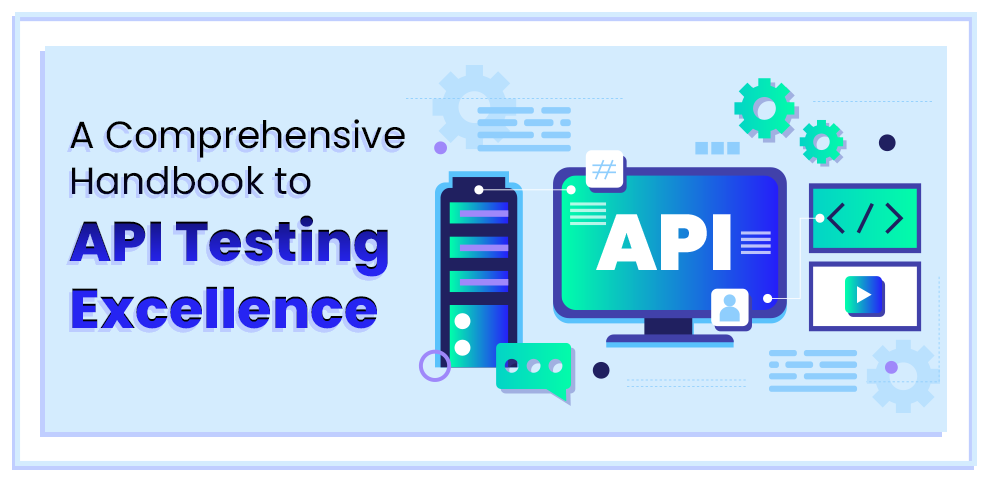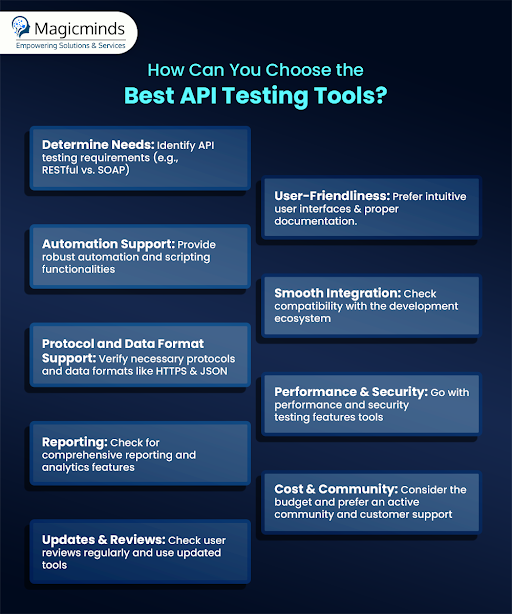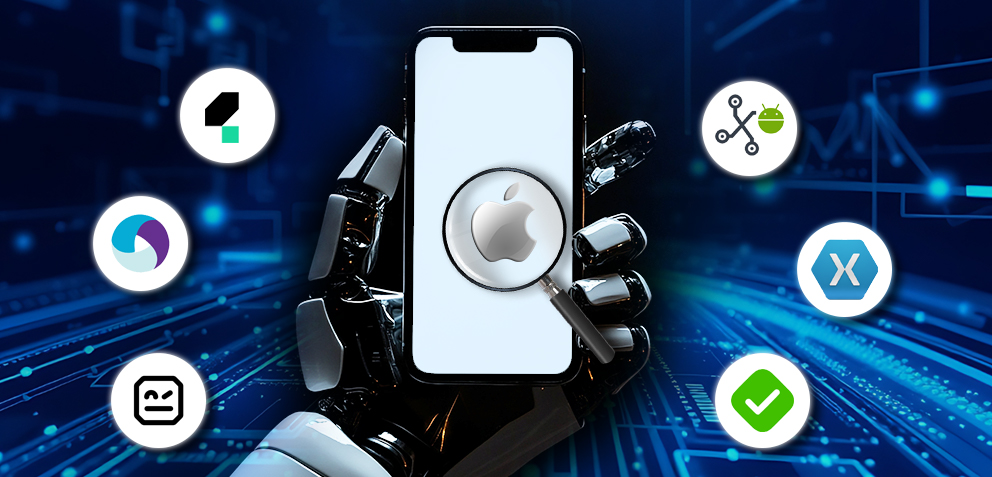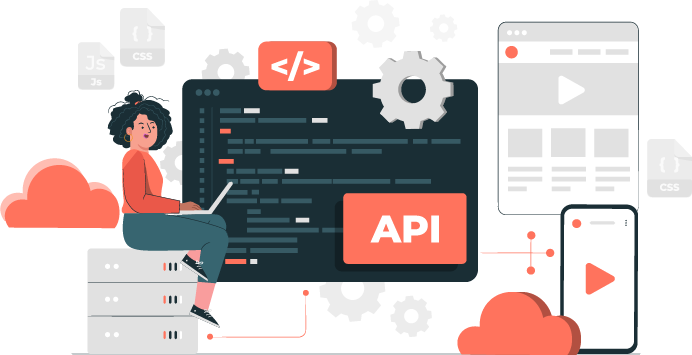API Testing 101: A Complete Approach to API Testing

Table Of Contents
 Stay In-the-loop
Stay In-the-loop
Get fresh tech & marketing insights delivered right to your inbox.
Share this Article
Tags
Category
- .Net Developer
- Adtech
- Android App Development
- API
- App Store
- Artificial Intelligence
- Blockchain Development
- Chatbot Development
- CMS Development
- Cybersecurity
- Data Security
- Dedicated Developers
- Digital Marketing
- Ecommerce Development
- Edtech
- Fintech
- Flutter app development
- Full Stack Development
- Healthcare Tech
- Hybrid App Development
- iOS App Development
- IT Project Management
- JavaScript development
- Laravel Development
- Magento Development
- MEAN Stack Developer
- MERN Stack Developer
- Mobile App
- Mobile App Development
- Nodejs Development
- Progressive Web Application
- python development
- QA and testing
- Quality Engineering
- React Native
- SaaS
- SEO
- Shopify Development
- Software Development
- Software Outsourcing
- Staff Augmentation
- UI/UX Development
- Web analytics tools
- Wordpress Development
Welcome to our complete handbook on API testing, where we delve deep into the world of API testing, its different types, and more. So, without further ado, let’s begin. Happy reading!
API Testing: A Brief Understanding
Application Programming Interface (API) is a specification that acts as an interface for software components. In software application development, API is the middle layer between the presentation (UI) and the database layer. APIs enable communication and data exchange from one software system to another.
API testing is a software testing practice that tests the APIs directly — from their functionality, reliability, performance, and security. Part of integration testing, API testing effectively validates the logic of the build architecture within a short amount of time. While most functional testing involves testing a user interface like a web page or a .NET form, API testing bypasses a user interface and communicates directly with an application by making calls to its APIs.
Additionally, API testing focuses on analyzing the business logic as well as the security of the application and data responses. An API test is usually performed by making requests to one or more API endpoints and comparing the response with the expected results.
However, partnering with an API testing service provider ensures reliability and functionality in API testing while reducing bugs.
Benefits of API Testing
API testing holds numerous benefits, ensuring robust, scalable, high-performing, and top-tier software quality.
- Earlier Testing: With API testing, once the logic is designed, tests can be built to validate the correctness of responses and data. This eliminates the need for various teams to complete their work or for full applications to be built—test cases are isolated and ready to be built Immediately.
- Easier Test Maintenance: UIs constantly change and move around based on how they are accessed—browsers, devices, screen orientation, etc. This creates a nightmare scenario where tests are constantly rewritten to keep up with the actual code in production. However, with API testing, this entire scenario changes, and you can easily maintain tests. API changes are much more controlled and infrequent – often, API definition files like OpenAPI Spec can help make refactoring tests only take a few seconds of work.
- Faster Time To Resolution: Even if API tests fail, we know exactly where our system broke, and the defect can be found. This helps reduce time triaging bugs between builds, integrations, and even different team members. An API test’s small, isolated footprint is perfect for faster MTTR stats, a valuable KPI for DevOps teams.
- Speed and Coverage of Testing: 300 UI tests may take 30 hours to run. However, 300 API tests could be run in 3 minutes. That means users will find more bugs in less time, while also being able to fix them immediately.
- Language-independent: Data is exchanged via XML and JSON formats, so any language can be used for test automation. XML and JSON are typically structured data, making the verification fast and stable. Built-in libraries also support comparing data using these data formats.
- GUI-independent: API testing can be performed in the app prior to GUI testing. Early testing means early feedback and better team productivity. The app’s core functionalities can be tested to expose small errors and to evaluate the build’s strengths.
- Improved test coverage: Most API/web services have specifications, allowing you to create high-coverage automated tests—including functional and non-functional testing.
Don’t Let Bugs Slow Down Your Software - Let Our API Testing Services Identify & Fix Bugs Early!
Types of API Testing
API testing typically involves the following practices:
- Unit testing – Testing the functionality of individual operations.
- Validation Testing – It occurs among the final steps and plays an essential role in the development process. It verifies the aspects of product, behaviour, and efficiency. In other words, validation testing can be seen as an assurance of the correct development.
- UI testing – It is defined as a test of the user interface for the API and other integral parts. UI testing focuses more on the interface that ties into the API than on the API testing itself. Although UI testing is not a specific test of API in terms of codebase, this technique still provides an overview of the health, usability, and efficiency of the app’s front and back ends.
- Functional testing – Testing the functionality of broader scenarios, often using unit tests as building blocks for end-to-end tests. Includes test case definition, execution, validation, and regression testing.
- Load testing – Validating functionality and performance under load, often by reusing functional test cases.
- Runtime error detection – Monitoring an application’s execution of automated or manual tests to expose problems such as race conditions, exceptions, and resource leaks.
- Security testing – Includes penetration testing and fuzz testing as well as validating authentication, encryption, and access control.
- Web UI testing – Performed as part of end-to-end integration tests that also cover APIs, enabling teams to validate GUI items in the context of the larger transaction.
- Interoperability testing – (SOAP only) Checking conformance to Web Services Interoperability profiles.
- Penetration testing – Considered the second test in the auditing process. In this type, users with limited API knowledge will try to assess the threat vector from an outside perspective, which is about functions, resources, processes, or the aim of the entire API and its components.
Related Read – Crowd-Sourced Testing 101: A Game-Changer for QA
API Testing Tools
Choosing the right API testing tools is extremely essential to determine the test’s success and efficiency. You must analyze different variables, such as usability, scalability, cost-friendliness, and compatibility with multiple current systems. Different types of tests also play a key role in choosing the right tool. We’ve made a list of API testing tools for your needs. Have a look:
- SoapUI: The tool focuses on testing API functionality in SOAP and REST APIs and web services.
- Apache JMeter: An open-source tool for load and functional API testing.
- Apigee: A cloud API testing tool from Google that focuses on API performance testing.
- REST Assured: An open-source, Java-specific language that facilitates and eases the testing of REST APIs.
- Postman: A Google Chrome app used to verify and automate API testing.
- Katalon: An open-source application that helps with UI automated testing.
- Swagger UI: An open-source tool that creates a webpage that documents APIs used.

Best Practices for API Testing
To ensure successful API testing completion, you can follow the below-mentioned best practices, ensuring maximum software quality. Here are the top tips:
- API Test cases should be grouped by test category.
- On top of each test, users should include the declarations of the APIs being called.
- Parameter selection should be explicitly mentioned in the test case itself.
- Prioritize API function calls so that they are easy for testers to test.
- Each test case should be as self-contained and independent from dependencies as possible.
- Avoid “test chaining” in test script development.
- Special care must be taken while handling one-time call functions like – Delete, CloseWindow, etc.
- Call sequencing should be performed and well planned.
- To ensure complete test coverage, create API test cases for all possible input combinations of the API.
Keep Your APIs Future-Ready With Our Comprehensive API Testing Services!
Book A Free Consultation!Challenges of API Testing
Common challenges in API testing consist of several aspects that testers often encounter, ensuring the reliability and functionality of API testing.
- The main challenges in Web API testing are Parameter Combination, Parameter Selection, and Call Sequencing. API testing involves a variety of data which can have multiple combinations. Determining which combinations to test and with what sort of parameters requires careful consideration; therefore, it becomes difficult to test with all possible combinations.
- This makes it difficult to give input values. The testers have to depend solely on the API documentation as they have limited visibility into the application’s functionality and behavior.
- Testers need Basic Coding knowledge. To test an API, testers need to understand how it works, including the request-response mechanism, status codes, headers, and payloads. Basic coding knowledge helps them understand these concepts more effectively.
- Validating and Verifying the output in a different system can be difficult for testers.- Validating data in different systems may compromise data security and privacy, especially when sensitive and confidential data is involved.
- The testers must be aware of parameter selection and categorization. Parameters are the inputs that drive the behaviour of an API. To test the API’s functionality effectively, testers need to understand each parameter’s purpose and expected values.
- Testing exception-handling functions ensures the application can effectively handle unexpected situations and errors.
Also Read – The Ultimate Guide to Manual Testing with Proven Best Practices
API Testing Solutions Powered By Magicminds!!
API testing is critical to software development, providing reliability, quality, performance, and security. A good strategy can ensure the success of API tests, accelerating the software development phase and offering boosted software quality. However, this requires hiring API testing services like Magicminds!
- 70% Bugs Reduction
- 55% Software Performance Improvement
- 45% Cost-Saving
- 35% User Satisfaction Increased
- 85% Test Coverage Enhanced
At Magicminds, our team of experts meticulously follows API testing best practices while leveraging tools tailored to your project needs. Partner with us to unlock robust API testing services today. Share Your Project Requirements!
Welcome to our complete handbook on API testing, where we delve deep into the world of API testing services, its different types, and more. So, without further ado, let’s begin. Happy reading!
| Table of Contents API Testing: A Brief Understanding Benefits of API TestingTypes of API TestingAPI Testing ToolsBest Practices for API Testing Challenges of API TestingAPI Testing Solutions Powered By Magicminds!! |
API Testing: A Brief Understanding
Application Programming Interface (API) is a specification that acts as an interface for software components. In software application development, API is the middle layer between the presentation (UI) and the database layer. APIs enable communication and data exchange from one software system to another.
API testing is a software testing practice that tests the APIs directly — from their
functionality, reliability, performance, and security. Part of integration testing, API testing
effectively validates the logic of the build architecture within a short amount of time. While most functional testing involves testing a user interface like a web page or a .NET form, API testing bypasses a user interface and communicates directly with an application by making calls to its APIs.
Additionally, API testing focuses on analyzing the business logic as well as the security of the application and data responses. An API test is usually performed by making requests to one or more API endpoints and comparing the response with the expected results.
However, partnering with an API testing service provider ensures reliability and functionality in API testing while reducing bugs.
Benefits of API Testing
API testing holds numerous benefits, ensuring robust, scalable, high-performing, and top-tier software quality.
- Earlier Testing: With API testing, once the logic is designed, tests can be built to validate the correctness of responses and data. This eliminates the need for various teams to complete their work or for full applications to be built—test cases are isolated and ready to be built Immediately.
- Easier Test Maintenance: UIs constantly change and move around based on how they are accessed—browsers, devices, screen orientation, etc. This creates a nightmare scenario where tests are constantly rewritten to keep up with the actual code in production.
However, with API testing, this entire scenario changes, and you can easily maintain tests. API changes are much more controlled and infrequent – often, API definition files like OpenAPI Spec can help make refactoring tests only take a few seconds of work.
- Faster Time To Resolution: Even if API tests fail, we know exactly where our system broke, and the defect can be found. This helps reduce time triaging bugs between builds, integrations, and even different team members. An API test’s small, isolated footprint is perfect for faster MTTR stats, a valuable KPI for DevOps teams.
- Speed and Coverage of Testing: 300 UI tests may take 30 hours to run. However, 300 API tests could be run in 3 minutes. That means users will find more bugs in less time, while also being able to fix them immediately.
- Language-independent: Data is exchanged via XML and JSON formats, so any language can be used for test automation. XML and JSON are typically structured data, making the verification fast and stable. Built-in libraries also support comparing data using these data formats.
- GUI-independent: API testing can be performed in the app prior to GUI testing. Early testing means early feedback and better team productivity. The app’s core functionalities can be tested to expose small errors and to evaluate the build’s strengths.
- Improved test coverage: Most API/web services have specifications, allowing you to create high-coverage automated tests—including functional and non-functional testing.
| Don’t Let Bugs Slow Down Your Software – Let Our API Testing Services Identify & Fix Bugs Early! Connect With us! |
Types of API Testing
API testing typically involves the following practices:
- Unit testing – Testing the functionality of individual operations.
- Validation Testing – It occurs among the final steps and plays an essential role in the development process. It verifies the aspects of product, behaviour, and efficiency. In other words, validation testing can be seen as an assurance of the correct development.
- UI testing – It is defined as a test of the user interface for the API and other integral parts. UI testing focuses more on the interface that ties into the API than on the API testing itself. Although UI testing is not a specific test of API in terms of codebase, this technique still provides an overview of the health, usability, and efficiency of the app’s front and back ends.
- Functional testing – Testing the functionality of broader scenarios, often using unit tests as building blocks for end-to-end tests. Includes test case definition, execution, validation, and regression testing.
- Load testing – Validating functionality and performance under load, often by reusing functional test cases.
- Runtime error detection – Monitoring an application’s execution of automated or manual tests to expose problems such as race conditions, exceptions, and resource leaks.
- Security testing – Includes penetration testing and fuzz testing as well as validating authentication, encryption, and access control.
- Web UI testing – Performed as part of end-to-end integration tests that also cover APIs, enabling teams to validate GUI items in the context of the larger transaction.
- Interoperability testing – (SOAP only) Checking conformance to Web Services Interoperability profiles.
- Penetration testing – Considered the second test in the auditing process. In this type, users with limited API knowledge will try to assess the threat vector from an outside perspective, which is about functions, resources, processes, or the aim of the entire API and its components.
API Testing Tools
Choosing the right API testing tools is extremely essential to determine the test’s success and efficiency. You must analyze different variables, such as usability, scalability, cost-friendliness, and compatibility with multiple current systems. Different types of tests also play a key role in choosing the right tool. We’ve made a list of API testing tools for your needs. Have a look:
- SoapUI: The tool focuses on testing API functionality in SOAP and REST APIs and web services.
- Apache JMeter: An open-source tool for load and functional API testing.
- Apigee: A cloud API testing tool from Google that focuses on API performance testing.
- REST Assured: An open-source, Java-specific language that facilitates and eases the testing of REST APIs.
- Postman: A Google Chrome app used to verify and automate API testing.
- Katalon: An open-source application that helps with UI automated testing.
- Swagger UI: An open-source tool that creates a webpage that documents APIs used.
Best Practices for API Testing
To ensure successful API testing completion, you can follow the below-mentioned best practices, ensuring maximum software quality. Here are the top tips:
- API Test cases should be grouped by test category.
- On top of each test, users should include the declarations of the APIs being called.
- Parameter selection should be explicitly mentioned in the test case itself.
- Prioritize API function calls so that they are easy for testers to test.
- Each test case should be as self-contained and independent from dependencies as possible.
- Avoid “test chaining” in test script development.
- Special care must be taken while handling one-time call functions like – Delete, CloseWindow, etc.
- Call sequencing should be performed and well planned.
- To ensure complete test coverage, create API test cases for all possible input combinations of the API.
| Keep Your APIs Future-Ready With Our Comprehensive API Testing Services! Book A Free Consultation! |
Challenges of API Testing
Common challenges in API testing consist of several aspects that testers often encounter, ensuring the reliability and functionality of API testing.
- The main challenges in Web API testing are Parameter Combination, Parameter Selection, and Call Sequencing. API testing involves a variety of data which can have multiple combinations. Determining which combinations to test and with what sort of parameters requires careful consideration; therefore, it becomes difficult to test with all possible combinations.
- This makes it difficult to give input values. The testers have to depend solely on the API documentation as they have limited visibility into the application’s functionality and behavior.
- Testers need Basic Coding knowledge. To test an API, testers need to understand how it works, including the request-response mechanism, status codes, headers, and payloads. Basic coding knowledge helps them understand these concepts more effectively.
- Validating and Verifying the output in a different system can be difficult for testers.- Validating data in different systems may compromise data security and privacy, especially when sensitive and confidential data is involved.
- The testers must be aware of parameter selection and categorization. Parameters are the inputs that drive the behaviour of an API. To test the API’s functionality effectively, testers need to understand each parameter’s purpose and expected values.
- Testing exception-handling functions ensures the application can effectively handle unexpected situations and errors.
API Testing Solutions Powered By Magicminds!!
API testing is critical to software development, providing reliability, quality, performance, and security. A good strategy can ensure the success of API tests, accelerating the software development phase and offering boosted software quality. However, this requires hiring API testing services like Magicminds!
- 70% Bugs Reduction
- 55% Software Performance Improvement
- 45% Cost-Saving
- 35% User Satisfaction Increased
- 85% Test Coverage Enhanced
At Magicminds, our team of experts meticulously follows API testing best practices while leveraging tools tailored to your project needs. Partner with us to unlock robust API testing services today. Share Your Project Requirements!


